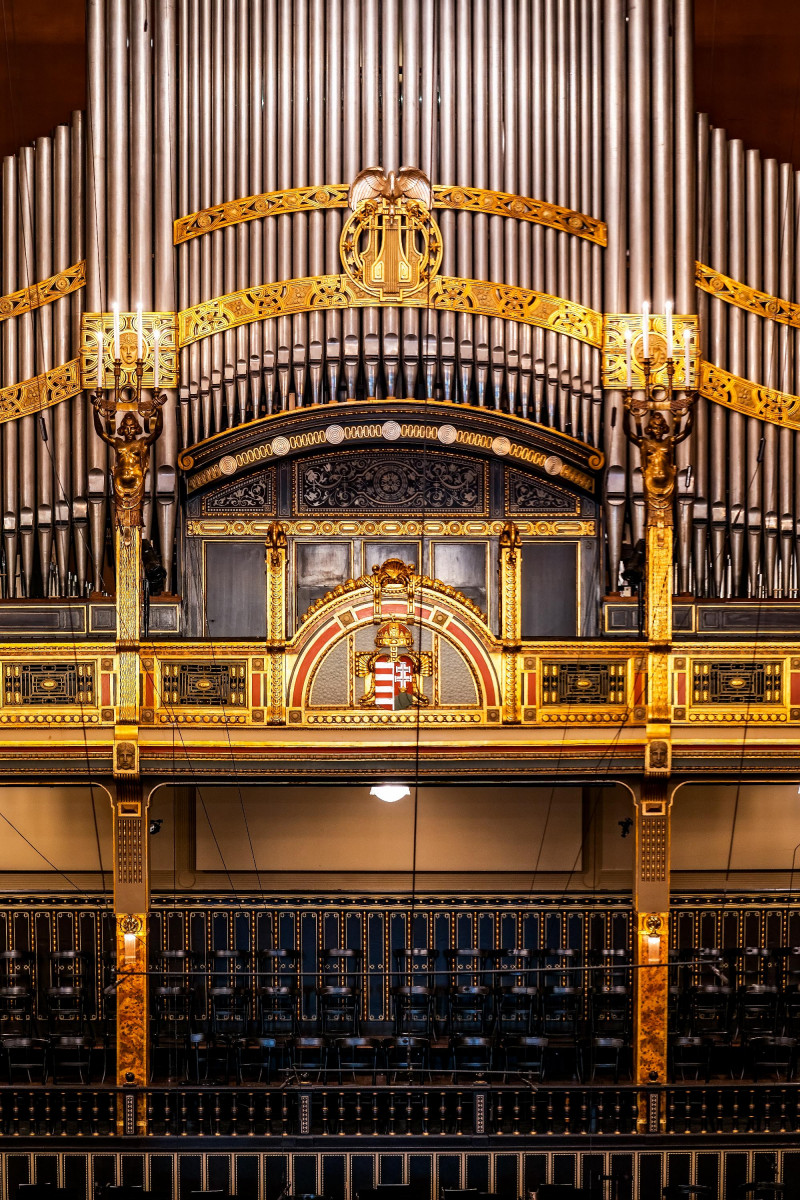A reconstruction effort accomplished
Summary on the last pages of a diary about a dream that has become a reality.

Among the many problems we faced during the restoration of the historic building of the Academy of Music in 2011–13, our most complex challenge was likely the “question of the organ”. At the beginning of the reconstruction effort, we knew that the musical instrument in the Grand Hall met neither the requirements of public performance and education nor the criteria for historical restoration that combined historical fidelity with state-of-the-art technology. Based on our experience, we assumed that the adventure of building a new organ would exceed the limits of the restoration in terms of time, space and funding. Hence, we planned, from the beginning, a separate and independent project, which would achieve the historical renovation of the building with the support of EU resources.
The 1907 Voit organ was built as an integral part of the historic building of the Liszt Academy of Music. The professional rationale for the reconstruction was developed by two young professors at the Liszt Ferenc Academy of Music, László Fassang and Balázs Szabó, and their arguments were submitted to the decision-making body of the Academy. Taking educational and artistic aspects into account, the Academy Senate took the decision to reconstruct the original instrument in 2010, which was also supported by Decree 1502/2012. (XI. 16.) issued by the Hungarian Government.

building a new organ would exceed the limits
of the restoration in terms of time, space and funding.”
Photo: János Posztós
The organ project had started adventurously, and it went on in the same way, from the quest for the original components through the difficulties of storing the instrument with a capacity of nearly 100 m3 to the elimination of the well-known technical problems of the original organ. Particular attention was paid to the parts which had a crucial effect on the final sound and intonational balance of the instrument. Compared to the conditions in 1907–08, the wind supply to the organ was considerably increased by the builders to sustain its sounding power even for the tutti fortissimo. During the restoration of the Grand Hall, the decades old thermal bridge behind the instrument was also eliminated: we sealed the flues running along the other side of the wall behind the organ, which had allowed cold air to blow over the instrument. The air-conditioning system in the Grand Hall was also designed according to the specific needs of the organ.

with a sound that is graceful and elegant,
free from obtrusion, affectation and ostentation.”
Photo: János Posztós
Among the surviving parts of the ill-fated instrument, the facade pipes stand out. They form the key visual element of the Grand Hall; without this division, the appearance of historical fidelity would be inconceivable. During the reconstruction of the Academy, we located the traces left in the building structure intended to house the original instrument, allowing us to see not just the original position of the facade pipes, but the first evidence of the unity between the instrument and the building achieved 110 years ago. With the repositioning of the facade, which had been condemned to silence as of the late 1960s, the Grand Hall regained not just the original proportions of its interior design, but also a highly valuable performance site, the organ gallery above the stage. This was one of the first moments in which we were amazed by the former symbiosis between the concert hall and the instrument. The location of the registers is not just practical and space-saving, but purposely facilitates the formation of the required sound. The extremely large surface of the Voit organ is spectacular: compared to the total surface area of the surrounding walls, the proportions of the facade and the two side divisions are much larger than those of most concert hall organs. The hall and the instrument complement each other perfectly. The organ has a wide dynamic range and a great tonal variety, with a sound that is graceful and elegant, free from obtrusion, affectation and ostentation.
Following an international public tendering procedure in 2015, the reconstruction of the Voit organ was carried out by the Germany-based Johannes Klais Orgelbau GmbH & Co. KG, founded in 1882, and its Hungarian partner AerisOrgona Kft. According to Philipp Klais, the owner and managing director of the internationally renowned German organ building workshop, the reconstruction effort was realised through international cooperation which made it possible once again for a truly significant European instrument to be played in the Grand Hall of the Liszt Academy of Music. The effort was also a remarkable contribution to the protection of the European Cultural Heritage, in which we can take great pride.
Gergely Lakatos
Chief engineer and project manager for the organ reconstruction


